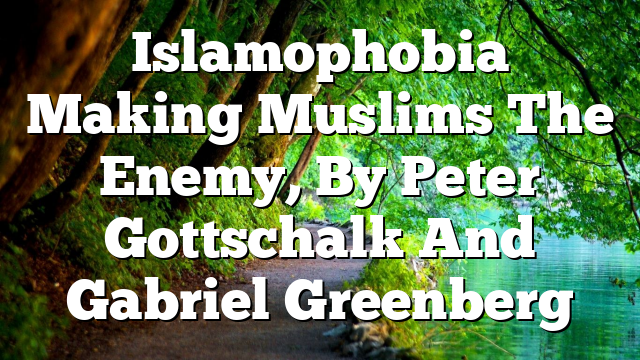Click to join the conversation with over 500,000 Pentecostal believers and scholars
Click to get our FREE MOBILE APP and stay connected
| PentecostalTheology.com



602
Book Reviews
Peter Gottschalk and Gabriel Greenberg,Islamophobia: Making Muslims the
Enemy(Plymouth,UK: Rowman & Littlefield Publishers, 2008). 181 pp. $24.95
hardback.
In Islamophobia: Making Muslims the Enemy, Peter Gottschalk and Gabriel Greenberg purpose is to expose the roles mid-twentieth and early twenty-first century Western religious and political cartoons have played in the creation of negative bias against the religion of Islam and Muslim peoples. They define Islamophobia as “a social anxiety toward Islam and Muslim cultures that is largely unexamined by, yet deeply ingrained in, Americans” (5).
Gottschalk and Greenberg base their arguments upon a compilation of car- toons drawn during politically tenuous times—which they deem misrepre- sented Islam and Muslims. These cartoons feature what became the West’s perception of Muslims during events such as the decolonization of Muslim- majority Egypt in the early 1950’s, the Arab Oil Embargo in the early 1970’s, all the chaos of 9/11, and the subsequent wars fought by the United States and coalition forces in Afghanistan and Iraq. Gottschalk and Greenberg very convincingly seek to demonstrate how these ongoing historic caricatures have developed into harmful present day stereotypes.
To provide a deeper historic context for the cartoons, Gottschalk and Green- berg preface the chapters that feature them by explaining the centuries-old conflict between the Christian West and the Islamic East.
Theauthorsbeginthebookwithanoverviewof whytheWestperceivesMus- lims as non-progressive, intolerant of other religions, aggressive and violent. Here they begin to discussIslamophobia. They challenge the reader who might be hesitant to believe his/her innate Islamophobic tendencies to look inward by engaging in the following exercise:
If you are skeptical about the notion of “Islamophobia,” get a piece of paper and brainstorm. Write down, with as little as thought and as much honesty as possible, all the words that come to mind when you think of the words “Islam” or “Muslim.” What names, places, events, ideas, prac- tices and objects do you associate with these terms?
3
The question is thoughtful, as it establishes mindset that helps readers to acknowledge personal bias and fear points.
The book moves from reasonable introspective questions and narrative to a somewhat incomplete exposition of Islam. In the first chapter’s summarized purview of the religion, its prophet Muhammad, and Europe’s historic early
PNEUMA
© koninklijke brill nv, leiden, 2018 | doi:10.1163/15700747-04004019
1
Book Reviews
603
encounters with Muslim peoples from the Middle East and North Africa, the text increasingly becomes biased. Authors Gottschalk and Greenberg present an Islam that is benign and faultless. They expose the Crusades (21) which lasted almost 300 years, but never mention the nearly one thousand years of Muslim invasion of Europe from the Battle of Tours in 732AD by the Moors to the second Battle for Vienna in 1683 by the Ottoman Turks. The reader who knows little about Islam’s history and orthodoxy comes away from this founda- tional chapter posed to believe the victimized status it will earn in the chap- ters that follow. The absence of any criticism that might decry some of Islam’s historical and present falsehoods is what makes society vulnerable to the dan- gerous aspects of Islam that are indeed noteworthy and should inform societal awareness and church missiology.There are always two sides to every story, and the bypassed truth of Islam’s dark side is this text’s silent scream.
Although the authors miss opportunity to offer a realistic portrayal of Islam, they do, indeed recover credibility with very fair discussion about Islamic sym- bols and how cartoonists have typically leveraged them to create and reinforce stereotypes in the minds and hearts of western observers. Cartoonists’ portray- als of the scimitar (sword), the mosque (Muslim place of worship) and minaret (tower where the call to prayer is announced), veiled women and turbaned men, beards and other visuals have regrettably shaped the psyche of western publics in a way that vilifies Muslims and prejudices Christians, the very ones who should be agents of blessing to them, to react to them with fear, apathy or deadening indifference.
The truth about power in media shouts loudly through Gottschalk and Greenberg’s research and expert connection of cartoon satire to current day fear of Muslims. Regardless of its source, Islamophobia’s curse is the separa- tion it wedges between Christians and Muslims, which distances the Christian from the Holy Spirit’s guidance and keeps Muslims from theTruth of the gospel.
Mark A. Hausfeld
Assemblies of God Theological Seminary, Springfield, Missouri hausfeldm@evangel.edu
PNEUMA 40 (2018) 563–624
2



Anonymous
https://timesofindia.indiatimes.com/world/europe/kremlin-rejects-volodymyr-zelenskiyy-claim-that-russia-wants-to-inflame-war-in-middle-east/articleshow/104310927.cms?from=mdr
Anonymous
While all will not say ‘Amen’ to that, it’s worthwhile to point out that Christianity has a foundation which cannot be destroyed…ever. Islam, on the other hand, depends on places and buildings for its continued existence.
From his book Winning the War Against Radical Islam “The terrorists and terrorist nations such as Saudi Arabia only fear one thing: the destruction of the religion of Islam. There is nothing in this life that has greater value to them than Islam. They are willing to sacrifice and even die to promote Islam. This religious motivation is the engine that drives the Jihad against us.
The path to Paradise, according to the Five Pillars of Islam, involves the city of Mecca and its stone temple called the Kabah. Muslims pray toward Mecca five times a day. What if Mecca didn’t exist anymore?
They must make a pilgrimage to Mecca and engage in an elaborate set of rituals centered around the Kabah once they arrive. What if Mecca and the Kabah were only blackened holes in the ground?
What if Medina, the burial place of Muhammad was wiped off the face of the planet?
What if the Dome Mosque on the Temple site in Jerusalem was blown up? The greatest weakness of Islam is that it is hopelessly tied to sacred cities and buildings. If these cities and buildings were destroyed, Islam would die within a generation as it would be apparent to all that its god could not protect the three holiest sites in Islam
Anonymous
“Islamophobia” just like the other phobias, such as transphobia, homophobia, etc. is a bullying term, having no genuine substance. These terms are used to ridicule and shame those who stand against the narrative and corrupted ideologies.
Do not be deceived. Do not be intimidated.
Anonymous
https://www.youtube.com/watch?v=z7ft_GFJNaA